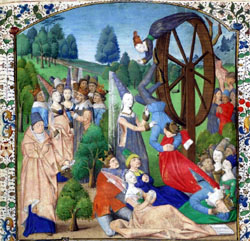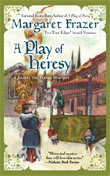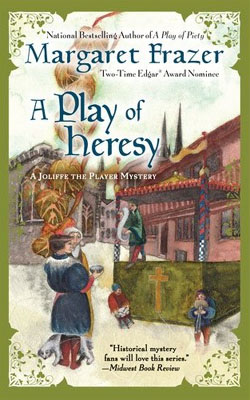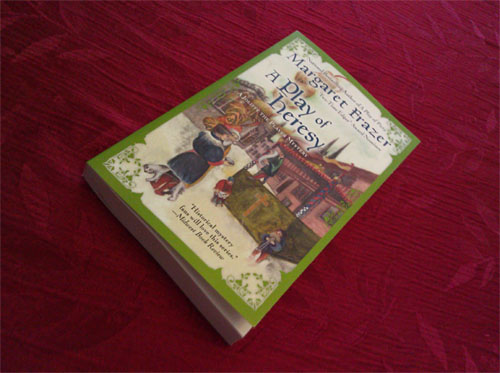CHAPTER 8
Joliffe went with him willingly, wanting escape from there almost as much as Powet did but even more wanting escape from the chill foreboding cramping at the base of his gut. He was never comfortable when Fortune, that treacherous goddess with her wheel that rolled you high only so she could roll you low, seemed to play suddenly into his hands. The mourning behind him was for a man expected home a week or more ago and now found dead, and Joliffe was afraid of the answer even as he questioned…
Of all medieval symbols that have lost their potency over the centuries, perhaps the most debased is Fortune’s Wheel.
Let me write “Wheel of Fortune” now, and what probably comes first to most modern minds is that long-running television game show dedicated to the fulfilling and frustration of plain greed. The medieval goddess Fortuna’s Wheel had a more complex meaning than that.
First, of course, Fortuna was not considered an actual goddess (polytheism not being an acceptable concept in medieval Europe). Like her Wheel itself, she was a symbol – a way of illustrating a complicated idea in an abbreviated, visual form. The symbol for a sports team or other popular product presently serves that same purpose, but Fortuna and her Wheel had deeper significance. Sight of them was supposed to remind mankind that nothing lasts.
 Pictures of Fortuna with her Wheel show a beautifully gowned woman, often crowned, often blindfolded, standing beside a giant, upright wheel in her control. Around the rim, small figures of humans cling. Some are obviously being carried upward toward the top of the Wheel where a richly garbed figure is always perched, an obvious winner who has Made It To The Top. But below him, opposite to the rising figures, are figures clinging desperately, head downward and all too plainly being carried down against their will, while at the Wheel’s bottom are those fallen as far as they can go, ragged and impoverished.
Pictures of Fortuna with her Wheel show a beautifully gowned woman, often crowned, often blindfolded, standing beside a giant, upright wheel in her control. Around the rim, small figures of humans cling. Some are obviously being carried upward toward the top of the Wheel where a richly garbed figure is always perched, an obvious winner who has Made It To The Top. But below him, opposite to the rising figures, are figures clinging desperately, head downward and all too plainly being carried down against their will, while at the Wheel’s bottom are those fallen as far as they can go, ragged and impoverished.
Particularly effective are pictures where the little figures around the rim are the same man, rising to the height of prosperity, only to be cast down by blind Fortune. But still Fortuna’s Wheel is always turning, and there he always is, still clinging to the rim, still trying to rise, always repeating the fate no human can escape – Life’s constant rise and downward sweep and rise again, only to sweep downward once more. Inconstant Fortune. This was meant to be a potent reminder of the world’s inconstant ways and a lesson to Man that he should strive to escape his clinging to Fortune’s Wheel by stepping away from worldly things and cleaving to those of the eternal realm of the spirit.
Not, of course, that this high purpose kept ordinary folk, in the ordinary way of things, from praying for Fortuna’s favor when they went to cast the dice or wager on a horse race.
– Margaret
Follow the virtual bookclub for A Play of Heresy on Facebook and Twitter.


















